|
The past two months we have gotten to celebrate the feast days of many incredibly saints who can be role models for us throughout all the ups and downs of life. This September is no different. As we transition out of summer and enter into new routines in the midst of the continuing pandemic, we can turn to many of the saints this month who are known for their healing and ability to help others grow in their faith. Saints Known for Physical Healing Earlier this month on September 1st, we celebrated the feast of St. Giles. I had never heard of St. Giles until I read a blog post, from the early days of the coronavirus pandemic, about the 14 Holy Helpers. But the more I got to learn about St. Giles, the more his life inspired my own personal faith journey. Even though an injury crippled one of his legs, St. Giles was known for his miracle-working abilities for those who came to him. His mission as a miracle-worker was always centered on others, not himself. A similar selflessness was seen by two martyrs in the early Church, Sts. Cosmas and Damian, whose feast we will celebrate on September 26th. They both were doctors and did not accept payment for any of their services, recognizing the humanity in each person. They utilized their God-given skills to help anyone in need, which led them to become recognized as the patron saints of physicians. All three of these saints remind me that while this world is not our final destination, taking care of our earthly bodies remains very important. In whatever way we may need physical healing, God is eager to hear us and to help us physically as we continue to live out His mission here on Earth. Saints Known for Spiritual Healing Next week, we will celebrate the feast of Our Lady of Sorrows. The Marian feast of Our Lady of Sorrows is special because it is about the spiritual turmoil Mary experienced during her life. This is why Our Lady of Sorrows is typically represented by seven daggers piercing her heart. For me, Our Lady of Sorrows is not just about praying for the intercession of Mary, but also placing our complete trust in the Lord, just like she did throughout the sorrows in her life. This trust was also central to St. Padre Pio’s ministry. He recognized the need for spiritual healing and committed to hearing Confessions, and he understood the significant act of faith it took to go to Confession. Through the intercession of Our Lady of Sorrows and St. Padre Pio, may we take time this month to trust God with spiritual healing in our lives. Role Model Saints for Spiritual Growth This month is bookended by two saints who are role models for integrating spiritual growth into the activities of their daily life: St. Teresa of Calcutta, whose feast was celebrated on September 5th, and St. Vincent de Paul, whose feast will be celebrated on September 27th. The interesting thing about these saints is that they both could have fallen into the categories of physical healing or spiritual healing. But for me, these well-known saints have been role models for integrating caring for other people with spiritual growth. It seems easy to get so focused on our work that we forget the deeper meaning behind it. Mother Teresa and St. Vincent de Paul worked to help those in need, and they saw Christ in everyone and in every task they did. While we may not be feeding the poor of Calcutta every day, we too can try to grow spiritually by seeing Christ in every aspect of our day. As we continue throughout this month of September, let us ask for the saints’ intercession for healing and learn from their lives in order to grow closer to Christ. To learn more about the saints, visit our Catholic Feast Days Website by clicking here. To view a calendar of the feast days in September, and each month, click here. **This blog was originally published on September 9, 2021**
0 Comments
As we continue through this summer, it can feel like the heat and humidity exhaust us to the point where everyday feels the same. It seems to be a never ending cycle of heat, mosquitoes and thunderstorms and I find myself focused on the negative as I just float along. However, when I have a goal in mind, something that I am striving towards, the hot days suddenly become more bearable. I need that jolt of fresh air to keep me going. Just like our physical lives, our spiritual lives in the summer can go through some exhaustion as well. For those who have not explored our Saint Website yet, we hope it can be a spark for you this August. For those of you who already look at our saints of the day, we have added five new saints this month that can hopefully be insightful and helpful for your prayer and reflection time throughout the month. Bl. Frédéric Janssoone Tomorrow we will celebrate the life of 19th century Franciscan Bl. Frédéric Janssoone. Although he lived and worked at the end of the 1800s, his life can still be a model for so many of us today. He was a missionary in Canada and was not only known for his missionary work, but also for his handling of the administrative tasks of the growing missionary efforts of the Franciscans there. Today, it is easy to compartmentalize ourselves as being good at one thing at a time, for example, either excelling at missionary work or administrative work. The life of Bl. Frédéric, however, shows us that with the guidance of the Holy Spirit we can combine both missionary and administrative work into a life of holiness. He is a wonderful example of how we can allow the Lord to work in our lives in many different ways. Bl. Frédéric Janssoone, Pray for Us St. Mary MacKillop On August 8th, we will celebrate the feast of St. Mary MacKillop. I found it interesting that St. Mary MacKillop lived at almost the exact same time as Bl. Frédéric Janssoone. Here are two people, from different walks of lives, in different parts of the world who both found their way to Sainthood. It gives us reason to believe that there are saints all throughout the world in our time. I also think that St. Mary MacKillop was inspirational because she was the first person to be canonized from Australia. It is always hard to be the first person for anything. Most people do not like to be put out of their comfort zone, much less to be the first person canonized as a saint in a specific country. Whether it be our career, our socioeconomic situation, or any other hardship we may face in our life, we can always look to St. Mary MacKillop as a role model for living a saintly life under challenging circumstances. St. Mary MacKillop, Pray for Us St. Alberto Hurtado In the middle of the month, we will celebrate St. Alberto Hurtado. He was a 19th century Chilean Jesuit. After joining the Jesuits, he noticed two main problems that would become the basis for his ministry. First, many Catholics in the country had very little interaction with a priest. Second, many of the poor, including children, did not have housing. St. Alberto Hurtado devoted his life to helping the people of Chile overcome these two problems and I encourage you to read more about his work! I am particularly inspired by the ability of St. Alberto Hurtado to notice the societal issues at the time and fix them with haste.. He did not wait for someone else to do it; he saw the need and he addressed it right away. In our lives, may we strive to be as receptive and adaptive as St. Alberto Hurtado and help those around us without hesitation. St. Alberto Hurtado, Pray for Us St. Joseph Calasanz The feast of St. Joseph Calasanz will be celebrated on August 25th. He lived and worked at the end of the 16th century and beginning of the 17th century in Italy. St. Joseph noticed that children from poor families were not able to receive an adequate education which would put them at a disadvantage later in life. This lack of education perpetuated the cycle of poverty among poor families and greatly reduced the educational success of their children. St. Joseph founded some of the first free schools in Rome which greatly helped these marginalized children in their attempt to escape this cycle. Let us learn, from the example of St. Joseph Calasanz, of the power that education has to lift people up and benefit everyone in society. St. Joseph Calasanz, Pray for Us St. Joseph of Arimathea The story of St. Joseph of Arimathea is one that most of us are familiar with from the Gospels. We will celebrate his feast on August 31st to close out the month. St. Joseph of Arimathea was a follower of Jesus who helped take Him down from the Cross and give Him a proper burial after his crucifixion. After he saw eleven of the twelve Apostles abandon Jesus during his Passion and the brutal death Jesus suffered, St. Joseph remained resolute in his faith and helped to care for Jesus during his death. Let us pray for the intercession of St. Joseph of Arimathea and ask that even in the most trying of times, we may, like him, stay committed to Christ and to the care of others. St. Joseph of Arimathea, Pray for Us To learn more about the saints, visit our Catholic Feast Days Website by clicking here.
While reflecting on the saints and blesseds that we newly added to our Feast Day website for this month of May, I was struck by the beauty in the diversity of lives they lived. One of the most important lessons I have learned is that there isn’t just one way to be a saint; in fact, there aren’t even one hundred set ways to be a saint. The way that God is calling us to be a saint is unique and individual to each one of us. I find it inspiring to learn about the lives of saints and take tidbits of their life as encouragement and motivation in my day-to-day path of following Christ. Bl. Sandra Sabattini Last week, we got to celebrate the feast of Bl. Sandra Sabattini. Before working on this project, I had never heard of Bl. Sandra; now she is someone I hope to read more about, and I find myself praying for her intercession. She was born in Italy in 1961, and after high school she worked in clinics helping those addicted to drugs. In her work there, she felt God’s call to work in medical missions in Africa, so she went to medical school. She was hit by a car and killed in 1984 when she was only twenty-two, but her legacy continues today because of her holiness. She strove to help others grow closer to Christ, no matter their situation, and she sought to do so by using her God-given gifts and talents in her own unique way to give back to the community. For me, as a young person in the biomedical field, the life of Bl. Sandra has many, many lessons. St. Dymphna This coming Monday we will celebrate the feast of St. Dymphna. If it wasn’t for their shared Catholic faith, I don’t think anyone would even mention St. Dymphna and Bl. Sandra in the same sentence. Dymphna was a seventh-century saint who was born into royalty, but upon her mother’s death, she had to flee from her mentally deranged father. She was martyred by her father when she was only fifteen because of her father’s desire to remarry. Throughout the centuries, St. Dymphna has grown to become the patron saint of mental health and those with nervous afflictions. Ultimately, while Bl. Sandra and St. Dymphna had very different lives, it is their same faith in Christ that guided and helped them live the saintly lives for which we remember them today. St. Paschal Baylón On Wednesday, May 17, we will celebrate a saint whose humility can inspire us to get through a challenging week and help us put everything in perspective. St. Paschal Baylón was a Spanish Franciscan brother in the sixteenth century. He grew up in a poor family, and before he joined the Franciscans, he was a shepherd. Upon joining the Franciscans as a brother, he held small but important roles in the community, like porter and gardener. He undertook these tasks with great dedication and would use his time in solitude during his work for personal contemplation. Paschal became known for his teachings on the Eucharist, which were rooted in his time spent in personal contemplation. As we live in this busy world of never-ending things to do, let us take time to allow a space for personal contemplation and conversation with God throughout our daily tasks. Bl. Louis-Zéphirin Moreau On the opposite side from a quiet, contemplative gardener is a bishop who spent his twenty-five years in the episcopate founding schools and churches throughout his diocese. Bl. Louis-Zéphirin Moreau was a nineteenth-century Canadian bishop who served as bishop of Saint-Hyacinthe from 1875 to 1901. As bishop, he helped revitalize the diocese by founding schools, churches, and two religious communities who served within the diocese. I can’t imagine how busy someone like Bishop Moreau must have been, trying to complete all of his tasks as bishop while at the same time trying to serve the diocese. Yet through it all, as many people commented during his beatification process, he maintained his personal piousness, never wavering in his devotion and trust in Christ throughout all of his work. So from the humble gardener to the revitalizing bishop, let us try to take a page from their book and take time in our weeks to give ourselves to Christ and let Him lead us. To learn more about the saints, visit our Catholic Feast Days Website by clicking here. Bl. Sandra Sabattini, pray for us. St. Dymphna, pray for us. St. Paschal Baylón, pray for us. Bl. Louis-Zéphirin Moreau, pray for us.
As part of our continuing efforts to grow the Catholic Feast Day Site, we have added one lesser-known saint or blessed per week. While these saints might not have the renown of St. Patrick or St. Francis of Assisi, they still are powerful role models and intercessors. When I was helping compile the resources to add these saints and blesseds to the site, I would try to put myself in their shoes. It is easy to write about them abstractly, just like a laundry list, but as I would imagine their situations, I would find myself in awe at how Christ worked through their life. During the rest of this month, we will celebrate the feasts of three incredible individuals in the life and history of the Church. St. Clement Mary Hofbauer Tomorrow, on March 15th, we will celebrate the feast day of the Redemptorist priest St. Clement Mary Hofbauer. Clement Mary Hofbauer lived from 1751 to 1820, a very tumultuous time in central Europe, especially around Poland and Austria where he lived. He helped open the first congregations of the Redemptorists north of Italy, helping the order spread throughout Europe. Clement Mary was responsive to the extreme poverty and need throughout Poland which was the result of the violent political conflict. He tried to help everyone he could. It must have felt like he was trying to drink from a fire hydrant with a straw, but he kept working for all the impoverished in Poland. Even after the political situation caused him to leave Poland for Vienna, he continued his work of helping individuals, even when some people might have seen it as futile. In honor of St. Clement Mary Hofbauer’s feast day, let us pray for his intercession, so that we too may trust that even when our works seem small, God can do great things through us. St. Rafqa Next week, on March 23rd, we will celebrate the feast of St. Rafqa. For me, St. Rafqa was one of those saints that made me glad I took the time to reflect on her life. Biographically, she was born in 1832 in Lebanon and died in 1914. She was a Mariamette Sister until 1871, and when the sisters merged with a different order, she joined the Lebanese Maronite Order and lived a quiet life of personal piety afterwards. That alone is impressive. But then I think about the incredible uncertainty and stress that must have come with the change from the Mariamette Sisters to the Lebanese Maronite Order. And I read that she lived the last twenty-nine years of her life with chronic headaches and eye pain, yet she continued her work in the order. Then she spent the last seventeen years of her life, while still in chronic pain, helping found a new monastery. In honor of St. Rafqa’s feast day, let us pray for her intercession, so that we too may keep Christ at the center of our lives, no matter the obstacles thrown in our way. Bl. Francesco Faà di Bruno On March 27th, we get to close out the month by celebrating the feast of Bl. Francesco Faà di Bruno. Faà di Bruno lived in the mid- and late nineteenth century in Italy. In the early part of his life, he was a well-known mathematician, especially renowned for his study of elliptic functions and higher order calculus. After becoming friends with St. John Bosco, Faà di Bruno became an active social reformer throughout Turin, helping those who otherwise would be forgotten by society. Unusual for the customs of the time, Faà di Bruno decided to become a priest in his late forties and spent the rest of his life as a priest, social reformer, and mathematician. It wasn’t that being a priest precluded him from being a mathematician; he lived his life in three-fold harmony. He even has a formula for high-level calculus named after him today! I find his life an inspiring model of how high-level math, faith, and social justice can all live in harmony while complementing each other. In honor of Bl. Francesco Faà di Bruno’s feast day, let us pray for his intercession, so that we too may let our God-given gifts shine and bring Christ’s love to others. St. Clement Mary Hofbauer, pray for us. St. Rafqa, pray for us. Bl. Francesco Faà di Bruno, pray for us. To learn more about the saints, visit our Catholic Feast Days Website by clicking here.
As I have gotten to work on our Feast Day website over my time working at the Catholic Apostolate Center, I have always been fascinated with saints that seemed extraordinary but whom I had never heard about before. I couldn’t believe that these saints weren’t more well known. Just when I thought there wasn’t possibly anything new I could read about in the life of a saint, I would learn something that left me awestruck. I knew we needed to add some of these lesser-known saints to our Feast Day website to help others learn about their tremendous lives. We have picked saints who are truly from all walks of life: from the early Church to the end of the twentieth century, from teenagers to those who didn’t devote themselves to Christ until the end of their lives, from artists to biochemists to hermits. I want to highlight the three we are celebrating in the remainder of February to help you become more familiar with them. Bl. Fra Angelico (February 18th) We will celebrate the feast of Bl. Fra Angelico at the end of this week. From his youth, Bl. Fra Angelico was an incredibly talented painter. Even with his skill and success, he listened to God’s call and joined the Dominicans. His time with the Dominicans allowed his artistic skills to flourish. The Dominican charism permeated all of his paintings, and he became one of the most successful painters of the early Renaissance period. I find it inspiring that while he was at the top of his field, he remained humble and committed to Christ and the Dominicans; he truly is a role model for all time. For his feast day this year, I am looking forward to looking at images of some of his most famous pieces of art and prayerfully meditating on the religious imagery and symbolism in them. Three of his works in which I always see something new are the San Marco Altarpiece, The Transfiguration, and the Madonna of Humility. Bl. Fra Angelico, Pray for Us! St. Lazarus Zographos (February 23rd) The week after Bl. Fra Angelico, we continue the artistic theme with the feast of St. Lazarus Zographos. St. Lazarus was a ninth-century iconographer and the first saint to be canonized who specifically dedicated himself to this trade. He was a renowned iconographer, which normally would bring praise and success, but he lived in a time of strict sentiment against iconography, and iconographers were persecuted throughout the Byzantine Empire. This didn’t deter St. Lazarus. He continued writing icons and even wrote them when he was in prison for doing so. While reading about St. Lazarus’ life, I learned that one should say “writing” rather than “painting” icons, because the process of creating an icon is about more than just painting; it is about the prayer, tradition, and the painting all coming together in the icon. While none of his icons exist today, for St. Lazarus’ feast day, let us learn more about his life and pray with icons from other iconographers. St. Lazarus Zographos, Pray for Us! St. Gabriel of Our Lady of Sorrows (February 27th) In the last week of the month, we will celebrate the feast of St. Gabriel of Our Lady of Sorrows. Compared to the other two saints above, St. Gabriel highlights the diversity in the lives of the blesseds and saints of the Church. St. Gabriel was a nineteenth-century Italian who suffered many illnesses and maladies in his youth. Each time he made a promise to himself that he would enter religious life if he got better. Even though he didn’t keep his promise many times, he finally did so and joined the Passionists after his sister died in the cholera epidemic. However, his life was cut short by tuberculosis when he was just twenty-three while still studying to be ordained a priest. Pope Benedict XV declared St. Gabriel the patron saint of Catholic youth as well as those studying for the priesthood. Sometimes the lives of saints who had established lives and successful careers, like Bl. Fra Angelico, can seem overwhelming. But a saint like St. Gabriel can be more relatable. Like us, he was just on his way and strove to live each and every day growing closer to Christ. For St. Gabriel of Our Lady of Sorrows’ feast, let us reflect on how we can grow closer to Christ throughout our everyday routines. St. Gabriel of Our Lady of Sorrows, Pray for Us! To learn more about the saints, visit our Catholic Feast Days Website by clicking here.
Throughout this July, we have the lives of three blesseds we can look to for inspiration in these modern times. All three of these blesseds lived during the 1900s and experienced many of the same ups and downs that we may face today. Today, we celebrate Bl. Maria Romero Meneses who lived from 1902-1977 and ministered in Nicaragua and Costa Rica. Then, on July 28th we will celebrate Bl. Stanley Rother who was born in Oklahoma in 1935 and martyred in Guatemala in 1981. Finally, on July 30th we will celebrate Bl. Solanus Casey, a Capuchin who lived from 1870 until 1957 and ministered in New York and Detroit for much of his life. The lives of all three of these blesseds can help guide us today. Bl. Maria Romero Meneses Bl. Maria Romero Meneses was born in Nicaragua in 1902 and in her youth, she became extremely sick, but after her arduous recovery, she committed herself to becoming a religious sister. She joined the Salesian Sisters when she was 27 and was transferred to Costa Rica where she completed most of her ministry. She focused on both helping the poor in her community and helping the rich understand how they could help those who were struggling. In today’s world, I find it can be easy to silo ourselves or others to just doing one thing, but, Bl. Maria is an example to us of helping those in need while also trying to help the structural causes of their need. While most of us won’t have the opportunity to work and minister in places like Nicaragua and Costa Rica, let us pray for Bl. Maria’s intercession for guidance on how to help the poor in our community and help change the structures that lead to poverty. Bl. Stanley Rother Bl. Stanley Rother was born in 1935 in Oklahoma. He became a priest for the Archdiocese of Oklahoma City and in 1968 was assigned to the Oklahoma mission to Guatemala with the Tzʼutujil people. While in Guatemala, Bl. Stanley did more than just preach, he founded a radio station and a hospital, taught language lessons, and did whatever else he could for the Tzʼutujil people. He even taught himself Spanish and the Tzʼutujil language so he could best minister and be present to the people there. Bl. Stanley ended up being killed during the Guatemalan Civil War because his missionary work put him in the middle of the two sides. One lesson I have learned from Bl. Stanley is how we can minister to people in so many ways, not just through preaching. He learned the Tzʼutujil language not just to preach, but so he could engage with the Tzʼutujil in their day-to-day life and be present to them. Bl. Solanus Casey On July 30th we will close out the month by celebrating the feast of Bl. Solanus Casey. Bl. Solanus was born in 1870 and entered the Capuchins around the turn of the century. He spent the first twenty years of his ministry in New York and then in 1924 was transferred to Detroit. While in Detroit, he mainly served as a porter at the Capuchin monastery. Even as he did the relatively simple task of a porter, Bl. Solanus was attentive to the visitors to the monastery and would pray with and for them for their illnesses and other hardships. He was renowned for his special Masses celebrated for the sick and people would travel just for these Masses with Bl. Solanus. I find the example of Bl. Solanus as the porter inspiring in our world today. He had a simple task, but he did it very intentionally and with great love, bringing many people closer to Christ. May we all pray for the intercession of Bl. Solanus to do our tasks with the same great intentionality and love! As we continue through this July, let us pray for the intercession of Bl. Maria Romero Meneses, Bl. Stanley Rother, and Bl. Solanus Casey as we strive to grow closer to Christ and bring other to Him. To learn more about the saints, visit our Catholic Feast Days Website by clicking here. To view a calendar of the feast days in July, and each month, click here.
As we conclude this June, we will celebrate four saints over three days who were crucial during the early days of the Church. Yesterday we celebrated St. Cyril of Alexandria. Today we celebrate St. Irenaeus. Tomorrow we will celebrate Sts. Peter and Paul. All these saints were instrumental in the spreading of the Gospel and in the formation of the Church during its first few centuries. Even though they lived long ago, their lives carry many messages for us today. St. Cyril of Alexandria St. Cyril was the bishop of Alexandria in the beginning of the 400s when the city was powerful politically and intellectually. Throughout his life, St. Cyril of Alexandria faced many political conflicts with other bishops, the patriarch of Constantinople, and the Roman emperor. However, even through these challenging situations, he remained steadfast in his faith and was a proliferous theological writer. Today he is counted among the Church Fathers and Doctors of the Church. One of the teachings of St. Cyril of Alexandria that has always stuck with me is his defense of Mary under the title of “Theotokos.” Theotokos roughly translates to “Mother of God” or “God-bearer” and has been a title of Mary in the Church, especially in Eastern churches, since the time of St. Cyril. Some of my favorite icons of Mary represent her as Theotokos and have really helped me grasp St. Cyril of Alexandria’s teaching. St. Irenaeus Today we celebrate the feast of St. Irenaeus. St. Irenaeus was a bishop in the 2nd century known during his lifetime as one of the last living connections to the Apostles. Like St. Cyril of Alexandria, St. Irenaeus was a prolific theologian who helped guide the Church through many theological controversies and heresies, most notably Gnosticism. For this theological impact on the Church, St. Iraneus was named a Doctor of the Church (just earlier this year by Pope Francis). If you like the nitty-gritty of theology, I encourage you to read more about St. Irenaeus. For me, the quote from St. Irenaeus that has had the biggest impact on my life is: “the glory of God is man fully alive.” I always found the word fully particularly inspiring. I connected this with John 10:10, “a thief comes only to steal and slaughter and destroy; I have come so that they might have life and have it more abundantly.” Throughout our life, in both the big events and the mundane events of day-to-day life, Jesus is calling us to full, abundant life. Sts. Peter and Paul Tomorrow we will celebrate the solemnity of Sts. Peter and Paul. Unlike a majority of saint’s feast days, the feast of Sts. Peter and Paul is celebrated as a solemnity as a sign of their importance to the early days of the faith. While there are many elements of the lives of Sts. Peter and Paul that could be explored, I have always found it striking that they are celebrated on the same day. After St. Paul’s conversion, St. Peter was in a very challenging position that took strong leadership guided by the Holy Spirit to navigate welcoming Paul into the community he once sought to kill. Then, throughout their time working together, they frequently did not see eye to eye on the important issues they faced. Yet, through their disagreements they kept the greater good of the Church in mind and both ended up being martyred for the faith. In our day and age, I think we all can learn a lot from the leadership and collaboration guided by the Holy Spirit exemplified by Sts. Peter and Paul, even when we do not necessarily get along with the people we are working with. Let us always pray for the intercession of St. Cyril of Alexandria, St. Irenaeus, and Sts. Peter and Paul as we strive to learn from their example and bring Christ to those in our lives. To learn more about the saints, visit our Catholic Feast Days Website by clicking here. To view a calendar of the feast days in June, and each month, click here.
This May, we have the joy of spending the whole month in the Easter season. We begin this month not far removed from Easter Sunday and end the month by celebrating the Ascension. Some parishes will also start a Pentecost Novena leading up to Pentecost on June 5th. One quirk of celebrating the saints is that when their feast day falls on a Sunday, we typically don’t get to celebrate them at Mass and learn about their lives. This May, there are three outstanding saints whose feasts fall on the three Sundays leading up to Pentecost. St. Isidore the Farmer The feast of the 11th and 12th century saint, Isidore the Farmer, is celebrated on May 15th. I find the life of St. Isidore the Farmer incredibly inspiring. St. Isidore was not a priest or member of the clergy. Rather, he was a pious farmer who was devoted to his work and also attended daily Mass. Through his commitment to farming and to the Eucharist, he was able to make a difference in his community and become a role model for other farmers. In today’s world, I sometimes find it hard to work in a more secular field while I have friends who work for the Church. I think of the example of saints like St. Isidore the Farmer who lived out their faith in their work and this witness inspires me hundreds of years later. As we prepare for Pentecost, let us pray for the intercession of St. Isidore the Farmer in living out our faith throughout our daily work. St. Rita of Cascia A week later, on May 22nd, we celebrate the feast of St. Rita of Cascia. St. Rita was a 15th century married Italian woman who eventually became an Augustinian nun. She is known as the patron saint of marital problems because of the way she gracefully handled her difficult marriage and her husband’s death by a feuding family. After her husband’s death, she cared for her sons and eventually became an Augustinian nun who devoted herself to praying for peace in the community of Cascia. Along with St. Jude, she is also known as a patron saint of lost and impossible causes. As we continue to prepare for Pentecost, let us pray for the intercession of St. Rita of Cascia in any challenges that may be holding us back from growing in our relationship with the Risen Christ. Pope St. Paul VI On May 29th we celebrate the feast of Pope St. Paul VI, one of the most recently canonized saints. Pope St. Paul VI continued the Second Vatican Council after the death of Pope John XXIII and helped implement many of the decisions and reforms that came from the Council. Many of these decisions were incredibly challenging, but Paul VI was able to navigate the situation and is highly respected for his ability to lead the Church in difficult times. Paul VI also helped grow ecumenical relations with Eastern Orthodox and Protestant churches—a model which continued into the papacies of his successors. As we continue to prepare for Pentecost, let us pray for the intercession of Pope St. Paul VI in making difficult decisions that ultimately will help us grow closer to God and to our neighbor. To learn more about the saints, visit our Catholic Feast Days Website by clicking here. To view a calendar of the feast days in May, and each month, click here.
This April, we have a busy season of liturgical events. From the conclusion of Lent to Palm Sunday, Holy Week, Easter, and the Octave of Easter, the entire Easter season is filled with solemn liturgies, commemorations, and celebrations. Through it all, we are called to grow in our relationship with the Lord. When every Sunday seems to be celebrating or commemorating something different, I often find myself turning to the saints for some consistency and routine. Saints to Prepare us for Holy Week This week, we celebrate three saints who can help us prepare for Holy Week. Today, we celebrate the 14th century Dominican St. Vincent Ferrer. He was a gifted intellectual who discerned God’s call for him to be a missionary and ultimately became known for his missionary work all throughout Europe. St. Vincent Ferrer incorporated his intellectual gifts into missionary work for the good of the universal Church. Yesterday, we celebrated another gifted intellectual in the history of the Church: St. Isidore of Seville. St. Isidore is known for his writings which helped spread the faith even long after he had died. On Thursday, we will celebrate St. John Baptist de la Salle. He is known for his educational reforms which included the founding of the Institute of the Brothers of the Christian Schools. Through prayer and discernment, he recognized the need for education reform which included having trained lay teachers. He devoted his life to increasing the access to education for those who normally would not get such opportunities. We can look to all three of these saints to help us prepare for Holy Week by allowing the Lord to work in our lives using the gifts He gave us. April 28th On April 28th, we will celebrate three saints who have left a great impact on the Church: St. Louis de Montfort, St. Peter Chanel, and St. Gianna Molla. St. Louis de Montfort was alive from the late 1600s to the early 1700s. Even though he died when he was only 43 years old, many of his writings form the basis of much of Mariology (the study of Mary) today. St. Peter Chanel was a 19th century Marist who was a missionary on the Polynesian island of Futuna. After four years of tireless work helping the islanders with daily life, Peter Chanel was martyred when the chief’s son converted to Catholicism. After his martyrdom, many of the islanders eventually converted to Catholicism, including the chief himself. Now the island (as well most of Oceania) has a strong devotion to St. Peter Chanel. Lastly, we will celebrate the 20th century saint, St. Gianna Molla on April 28th. St. Gianna Molla was an Italian pediatrician who refused an abortion and hysterectomy despite her life-threatening pregnancy and eventually died after giving birth. She is known for following the teachings of the faith while serving as a doctor and is a model for Catholics practicing medicine today. As we enter this liturgically busy April, let us look to the saints we celebrate this month for inspiration in following God’s will throughout our lives using the gifts He has given us. To learn more about the saints, visit our Catholic Feast Days Website by clicking here. To view a calendar of the feast days in April, and each month, click here. For more Lenten and Easter resources, please click here.
On the Center’s Feast Day Website, March is the month with the least number of feast days, 11 in total. But, this doesn’t mean that there isn’t a range of saints and life experiences represented this month. Two of the saints in March are perhaps some of the most well-known saints: St. Patrick and St. Joseph. Also this month, we will celebrate a famous American saint, St. Katharine Drexel, an influential Peruvian, St. Turibius of Mogrovejo, and one of my favorite saints, the Salvadoran St. Oscar Romero. St. Katharine Drexel St. Katharine Drexel was born in 1858 in Philadelphia. She was born into a wealthy family and inherited a large sum of money after her father died. Katharine and her sisters wanted to help Native Americans and African Americans with the money they inherited. In a private meeting with the pope, he recommended that Katharine become a sister to carry out the work she wanted to do. Doing this, however, would require Katharine to leave the affluent social circles of Philadelphia. She decided that she was being called to religious life and founded the Sisters of the Blessed Sacrament. To this day, the Sisters founded by Katharine continue to work for the education of Native Americans and African Americans across the United States. I find St. Katharine Drexel’s life particularly admirable because of the courage it must have taken to step into the unknown of founding a religious community even though she had such security in the wealth of her inheritance. St. Turibius of Mogrovejo The feast of St. Turibius of Mogrovejo is celebrated on the day of his death, March 23rd. He became archbishop of Lima, Peru in 1580, moving from his native Spain to Peru to be the archbishop. While he was archbishop, he focused on evangelization throughout his diocese. This included many, many baptisms, including baptizing eventual saints Rose of Lima and Martin de Porres. Turibius also focused on incorporating the indigenous languages into the work of the priests throughout the diocese. Personally, I think St. Turibius’ wisdom and understanding carries many lessons for us today. His ability to go into an unknown place and work with the local community can be a model for our efforts in the New Evangelization. Let us not forget the local community and culture of where we might minister, but collaborate with the culture and community. St. Oscar Romero One of my favorite saints is St. Oscar Romero. I did not know much about the life of St. Oscar Romero until I visited El Salvador in 2019. While I was in El Salvador, I got to visit his tomb as well as the chapel where he was celebrating Mass when he was killed. Romero was named the archbishop of San Salvador in 1977 because he was considered a safe, non-divisive choice in the country that had extreme political unrest. However, Romero saw the extreme suffering of the people of El Salvador and devoted himself as archbishop to speak out against the injustices faced by Salvadorans. He knew that doing this put his own life in extreme danger, but he was willing to do so to help Salvadorans. In 1980, after only 3 years as archbishop, Romero was shot and killed while celebrating Mass. Today, Romero is one of the most well-known and respected Salvadorans. Whether you know a lot or nothing at all about St. Oscar Romero, I encourage you to read more about his life, especially the homilies and speeches he gave to all of the people of El Salvador. This March, let us learn more about the lives of St. Katharine Drexel, St. Turibius of Mogrovejo, and St. Oscar Romero and ask for their intercession in our lives and in the life of the Church. To learn more about the saints, visit our Catholic Feast Days Website by clicking here. To view a calendar of the feast days in March, and each month, click here.
As we continue into the second month of 2022, let us learn from the saints we celebrate this February. While this is a shortened month, there are three instances this month where we get to celebrate two saints on the same day. On February 8th, we will celebrate both St. Jerome Emiliani and St. Josephine Bakhita. Then, two days later, we celebrate both St. Scholastica and St. Jose Sanchez del Rio. Finally, on February 21st, we celebrate both St. Peter Damian and Bl. Richard Henkes. May their witness of the faith inspire us to follow in their footsteps and grow in our faith throughout the month. February 8th One of the saints who we will celebrate on February 8th is St. Jerome Emiliani. After his conversion of heart as a prisoner of war, he worked tirelessly for orphans and the poor in his community. He founded the Somaschi Fathers who, even today are committed to helping orphans, the poor, and the sick. He became well known for his zeal and his work has continued now almost 500 years later. On the same day, we will also celebrate St. Josephine Bakhita. She was born in 1869 in Sudan. As a child, Bakhita was forced into slavery. Eventually she ended up in Italy where she was freed and converted to Catholicism. She then became a Canossian Sister and devoted the rest of her life to her faith. Throughout her life, she was known as a role model for forgiveness and continuing to grow in her faith. February 10th One of the saints whose feast is on February 10th is St. Scholastica. St. Scholastica is known as the twin sister of St. Benedict, the founder of the Benedictines. Once a year, St. Scholastica and her brother would meet and discuss many aspects of the faith to help each other and the other Benedictines in their care. Their strong relationship continued until St. Scholastica’s death, just three days after her annual visit with Benedict. Because of her work with her brother, St. Scholastica is now the patron saint of Benedictine nuns. Living almost a century and a half later was St. Jose Sanchez del Rio. During the Cristero War in Mexico, Jose was captured and tortured to try and get him to renounce his Catholic faith. However, Jose remained committed to his faith and was martyred at the age of 14. I find it incredibly inspiring that both St. Scholastica and St. Jose Sanchez del Rio became saints even though their lives were so different. Their examples show that God calls each of us to sanctity in a unique way. February 21st St. Peter Damian lived in the 11th century and came from very humble beginnings. He was orphaned at a young age and spent most of his childhood uneducated and underfed. Eventually, one of his brothers took him in to be educated. Peter proved incredibly gifted in theological matters. He spent his life as a monk engaged in theological disputes during a challenging period in the Church. Today, St. Peter Damian is recognized as a Doctor of the Church, showing that his initial lack of education did not define the rest of his life – skilled theologians can come from anywhere. Also celebrated on February 21st is Bl. Richard Henkes. Bl. Richard Henkes was a Pallottine priest who was initially arrested by the S.S. in 1938 for speaking out against Nazism. Even after he was released in 1939, he continued preaching against the Nazi regime. After being arrested a second time and sent to the Dachau concentration camp, he volunteered to care for the sick there. Father Henkes ultimately became ill, dying from the disease. He is remembered for his unending selflessness. As we continue in 2022, let us reflect on the lives of these saints from these three days as role models we can continue to look to throughout this month. To learn more about the saints, visit our Catholic Feast Days Website by clicking here. To view a calendar of the feast days in February, and each month, click here.
As we start 2022, the lives of the saints can be an inspiration for us in our faith journey this year. Today we celebrate St. André Bessette and tomorrow we celebrate St. Raymond of Penyafort. While they lived two very different lives, they help show us that there is a unique path to holiness for each of us. On January 17th we will celebrate St. Anthony who is known as the founder of modern-day monasticism in the 4th century. Then, at the end of the month we will celebrate St. Marianne Cope and St. Angela Merici, both female religious whose lives we can look to this new year.
Saints We Celebrate Today and Tomorrow Today, January 6th, we celebrate the feast of St. André Bessette. Brother André was a brother in the Congregation of the Holy Cross in the 19th and 20th century in Canada. He had a great devotion to St. Joseph which led him to recommend devotion to St. Joseph to those who were sick. This led to Brother André’s reputation as a miracle worker. Even as his reputation grew, he remained devoted to St. Joseph and made sure he was the center of his ministry. Tomorrow we will celebrate the feast of St. Raymond of Penyafort. St. Raymond is known for his work compiling canon laws and he is known as the patron saint of canon lawyers. Both of these saints came to know Christ in radically different ways and had very different life paths, but they both lived their lives for Christ. I find their feast days back-to-back particularly inspirational that Christ has a unique path to holiness for each of us. St. Anthony the Great St. Anthony the Great lived in Egypt in the 3rd and 4th centuries and is known as the father of monasticism. Last year, I had to read the Life of Anthony written by St. Athanasius. It is the source for most of what we know about St. Anthony and helped spread St. Anthony’s life to other monks. Even though I had to read it for class, I found my own faith being strengthen by this ancient text. What particularly stood out to me in the text was that even though St. Anthony wanted to be a monk and removed from earthly distractions, he recognized where God was calling him and followed His will. Many of the stories for the Life of Anthony have helped me grow in my own faith and realize that even when I sometimes want to be far removed from a situation, we ultimately need to listen for God’s will for us. I encourage you to prayerfully read through the Life of Anthony this new year. Inspirational Female Religious On January 23rd we will celebrate the feast of St. Marianne Cope. She is known for working with St. Damien in the leper colony at Molokai. Even though working with leprosy suffers could be dangerous, St. Marianne Cope led her religious community to helping the king of Hawaii with Molokai. She took on the challenge and devoted her life to caring for leprosy sufferers, recognizing that they were not defined by their illness. Her courage and dedication can be an inspiration to us this new year. Then, on January 27th we will celebrate St. Angela Merici. She founded the Company of St. Ursula which became a religious community that was focused on the education of young girls. Like St. Marianne Cope many centuries after her, St. Angela Merici had the courage and dedication to found this community and focus on girls’ education even at a time when this was not very common. Let us pray for the intercession of both of these saints for the same courage and dedication they showed throughout their lives. In the beginning of this new year, let us pray for the intercession of these and all the saints to help us grow in our relationship with God and to follow His will. To learn more about the saints, visit our Catholic Feast Days Website by clicking here. To view a calendar of the feast days in January, and each month, click here.
This November, many of the saints we celebrate have left a lasting impact in the Church. Three of the saints this month were known as “the Great”, all for unique reasons. We also will get to celebrate four lay women saints whose lives can still inspire us today. In addition, two days before Thanksgiving this year, on November 23rd, we will celebrate three feasts of men who all lived very different lives, but all devoted their faith to the faith. “The Greats” The first feast of “the Greats” in November is St. Leo the Great on November 10th. St. Leo the Great was a pope in the 5th century who is known as “the great” for saving Rome from invasion and thus saving the Church community in Rome. He is also known for his writings, which led to him being named a Doctor of the Church. On November 15th, we will celebrate the feast of St. Albert the Great: a 13th century Dominican known for both writing on the works of Aristotle and being the teacher to St. Thomas Aquinas. He is known as “the great” today for many of his intellectual contributions to the Church, which has also led to him being known as the patron saint of scientists and philosophers. The day after St. Albert the Great, we celebrate St. Gertrude the Great. She was as a mystic and was given the title of “the great” because of her deep theological and spiritual insights. While all these “greats” lived quite different lives, they became recognized as greats for their deep commitment to their faith throughout all aspects of their life. Lay Women On November 16th, we will celebrate St. Margaret of Scotland. When she was Queen of Scotland in the 11th century, she was known for her piety and using her position as queen for charitable works for all of the people of Scotland. She’s a great example to us of staying focused on our faith and charitable actions even through stressful times. I find it fitting that we will celebrate St. Elizabeth of Hungary the day after St. Margaret of Scotland. Even though St. Elizabeth of Hungary, a princess in the 13th century, only lived until 24, she used her wealth to establish a hospital and care for sick patients. Even though she didn’t live a long time, she is known as the patron saint of hospitals and nurses today. On November 22nd, we will celebrate St. Cecilia. St. Cecilia was martyred in the early Church and because of her musical passion, she is known as the patron saint of musicians today. Then, on November 25th we will celebrate St. Catherine of Alexandria, a saint from the early Church who converted to Christianity and then used the rest of her life to challenge pagan philosophers and engage with the intellectual components of the faith. All four of these lay women have greatly impacted the Church and continue to inspire us today. November 23rd On November 23rd, we will celebrate three feasts, a rare day where we have three separate feasts to celebrate. The first one chronologically is Pope St. Clement I, a pope at the end of the first century. Even after being exiled, he continued to work miracles, to the point where it cost him his life through martyrdom. St. Columban was a missionary is the 6th and 7th centuries who is known as one of the proto-missionaries in Europe. St. Columban is primarily known for his missionary work in Ireland where he helped establish the monastic tradition. Bl. Miguel Agustin Pro was a Jesuit priest in Mexico in the 1800s when public worship was illegal. Despite the fact the public worship was illegal, he continued to lead his people in the sacraments. He was eventually martyred; he is known for stretching out his arms as he was being killed and saying, “Viva Cristo Rey!” As we continue this November, let us pray for the intercession of these powerhouse saints, praying for their intercession to boldly life out our faith throughout our lives. To learn more about the saints, visit our Catholic Feast Days Website by clicking here. To view a calendar of the feast days in November, and each month, click here.
This October, as summer turns to fall and the days start getting shorter, we sometimes find ourselves with opportunities to reflect on some of life’s bigger questions. I often find myself this season asking deep questions on a nice walk outside while admiring the beauty of nature. A lot of times, these big life questions usually involve prayer, discernment, and looking to role models. When I sat down to look at the saints whom we celebrate this October, I realized that many of them had to face similarly tough life questions. The popes, young people in the Church, and martyrs we celebrate this October can help us grow in our own faith journey. Pope Saints Next week, we will celebrate two saints who were popes, albeit at vastly different times. On October 14th, we will celebrate the feast of St. Callistus I (also know as Callixtus I). For many, he is probably one of the lesser-known pope saints. He was the 16th pope and had to deal with great division in the Church. He was able to navigate the Church through many doctrinal controversies through these turbulent times and was martyred around the year 222. Similarly, St. John XXIII navigated through many challenging questions in the Church when he opened the Second Vatican Council in 1962. It was through much prayer and discernment that both popes were able to guide the Church out of murky waters. Later this month, we will celebrate Pope St. John Paul II. One of my favorite John Paul II quotes epitomizes the courage he calls all of us to in living out our faith: “Do not be afraid. Do not be satisfied with mediocrity. Put out into the deep and let down your nets for a catch.” Saints who had an impact in their youth Already this month, we have celebrated two saints who had a major impact on the Church while in their youth: St. Thérèse of Lisieux and St. Francis of Assisi. St. Thérèse, who died at 24, was known for her life of fervent prayer. She was a cloistered Carmelite nun whose prayer was not focused on herself, but on the whole world. She is known as one of the patron saints of missionaries even though she lived as a cloistered nun. St. Francis of Assisi also had a huge impact on the Church while still young. St. Francis was in his 20s when he heard God’s call in the chapel at San Damiano, but it took him time and further prayer to realize God’s true calling for him. St. Francis’ perseverance in the faith and continual discernment of God’s call, even in times of confusion, inspire me. Bl. Carlo Acutis, beatified just last year, also positively impacted the Church in his youth. Bl. Carlo was an amateur computer programmer who died in 2006 at the age of 15. He used his passion for computers to create a website documenting Eucharistic miracles across the world. Martyrs from all ages Throughout the rest of the month, we will celebrate the feast days of martyrs from all time periods in the Church. This includes the memorial of two Apostles: Sts. Simon and Jude. While not much is known about the lives of Sts. Simon and Jude, it is known that they both were killed for their faith. Also martyred in the time of the early Church was St. Ignatius of Antioch. He is known for his incredible writings on Christology. St. Denis was also a martyr in the time of the early Church. Many portrayals of St. Denis will show him holding his head in his arms because after his was martyred, legend has it that he held his head and shared Christ with those who killed him. On October 19th we will celebrate Sts. John de Brebuf and Isaac Jogues, the patron saints of North America. They were killed in the 17th century while ministering to the Iroquois. Even though they had previously been captured and knew that they could be killed, they placed all of their trust in God and continued their missionary work. Throughout the rest of this October, let us pray for the intercession of these saints in helping us be courageous in prayer and discerning God’s continuing will for us. To learn more about the saints, visit our Catholic Feast Days Website by clicking here. To view a calendar of the feast days in October, and each month, click here.
The past two months we have gotten to celebrate the feast days of many incredibly saints who can be role models for us throughout all the ups and downs of life. This September is no different. As we transition out of summer and enter into new routines in the midst of the continuing pandemic, we can turn to many of the saints this month who are known for their healing and ability to help others grow in their faith. Saints Known for Physical Healing Earlier this month on September 1st, we celebrated the feast of St. Giles. I had never heard of St. Giles until I read a blog post, from the early days of the coronavirus pandemic, about the 14 Holy Helpers. But the more I got to learn about St. Giles, the more his life inspired my own personal faith journey. Even though an injury crippled one of his legs, St. Giles was known for his miracle-working abilities for those who came to him. His mission as a miracle-worker was always centered on others, not himself. A similar selflessness was seen by two martyrs in the early Church, Sts. Cosmas and Damian, whose feast we will celebrate on September 26th. They both were doctors and did not accept payment for any of their services, recognizing the humanity in each person. They utilized their God-given skills to help anyone in need, which led them to become recognized as the patron saints of physicians. All three of these saints remind me that while this world is not our final destination, taking care of our earthly bodies remains very important. In whatever way we may need physical healing, God is eager to hear us and to help us physically as we continue to live out His mission here on Earth. Saints Known for Spiritual Healing Next week, we will celebrate the feast of Our Lady of Sorrows. The Marian feast of Our Lady of Sorrows is special because it is about the spiritual turmoil Mary experienced during her life. This is why Our Lady of Sorrows is typically represented by seven daggers piercing her heart. For me, Our Lady of Sorrows is not just about praying for the intercession of Mary, but also placing our complete trust in the Lord, just like she did throughout the sorrows in her life. This trust was also central to St. Padre Pio’s ministry. He recognized the need for spiritual healing and committed to hearing Confessions, and he understood the significant act of faith it took to go to Confession. Through the intercession of Our Lady of Sorrows and St. Padre Pio, may we take time this month to trust God with spiritual healing in our lives. Role Model Saints for Spiritual Growth This month is bookended by two saints who are role models for integrating spiritual growth into the activities of their daily life: St. Teresa of Calcutta, whose feast was celebrated on September 5th, and St. Vincent de Paul, whose feast will be celebrated on September 27th. The interesting thing about these saints is that they both could have fallen into the categories of physical healing or spiritual healing. But for me, these well-known saints have been role models for integrating caring for other people with spiritual growth. It seems easy to get so focused on our work that we forget the deeper meaning behind it. Mother Teresa and St. Vincent de Paul worked to help those in need, and they saw Christ in everyone and in every task they did. While we may not be feeding the poor of Calcutta every day, we too can try to grow spiritually by seeing Christ in every aspect of our day. As we continue throughout this month of September, let us ask for the saints’ intercession for healing and learn from their lives in order to grow closer to Christ. To learn more about the saints, visit our Catholic Feast Days Website by clicking here. To view a calendar of the feast days in September, and each month, click here.
|
Details
Archives
July 2024
Categories
All
|
About |
Media |
© COPYRIGHT 2024 | ALL RIGHTS RESERVED

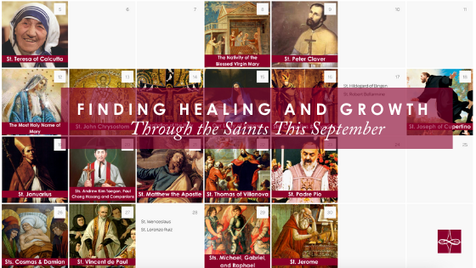

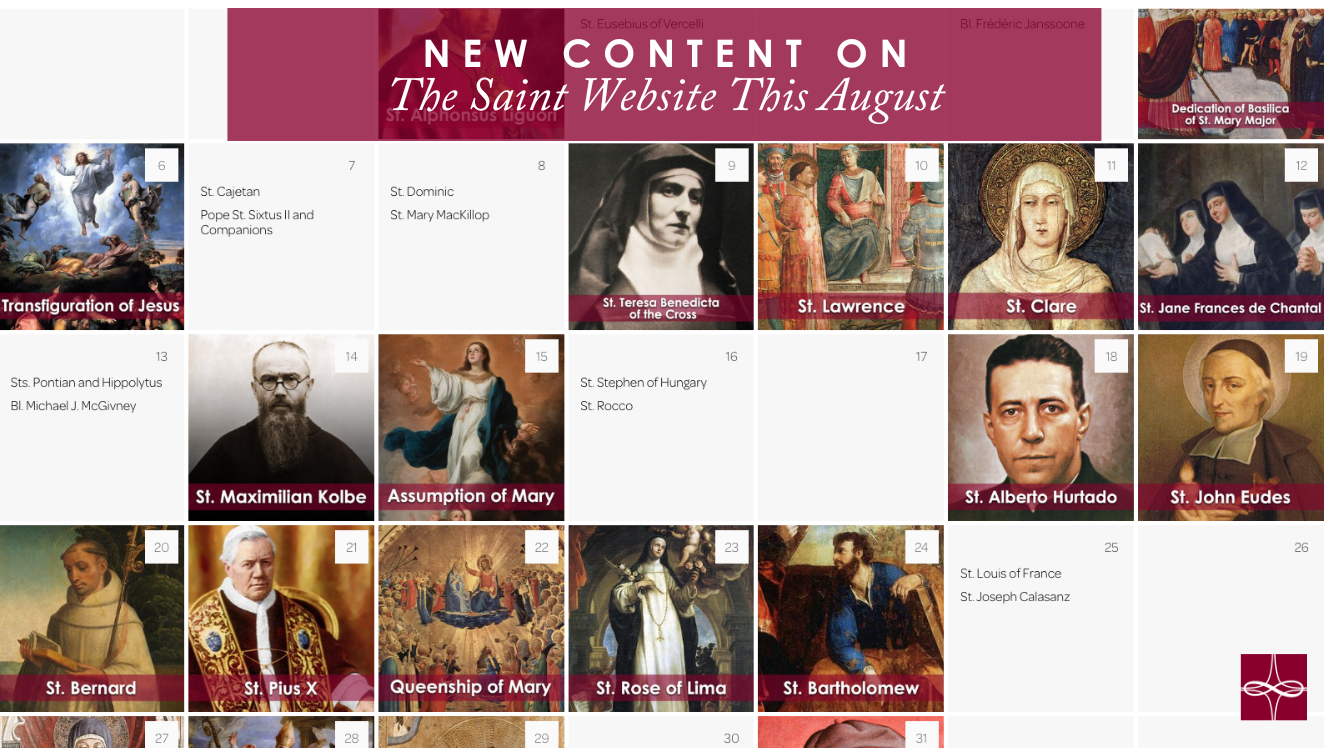
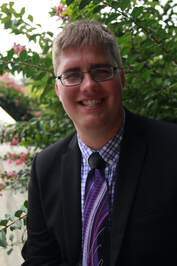
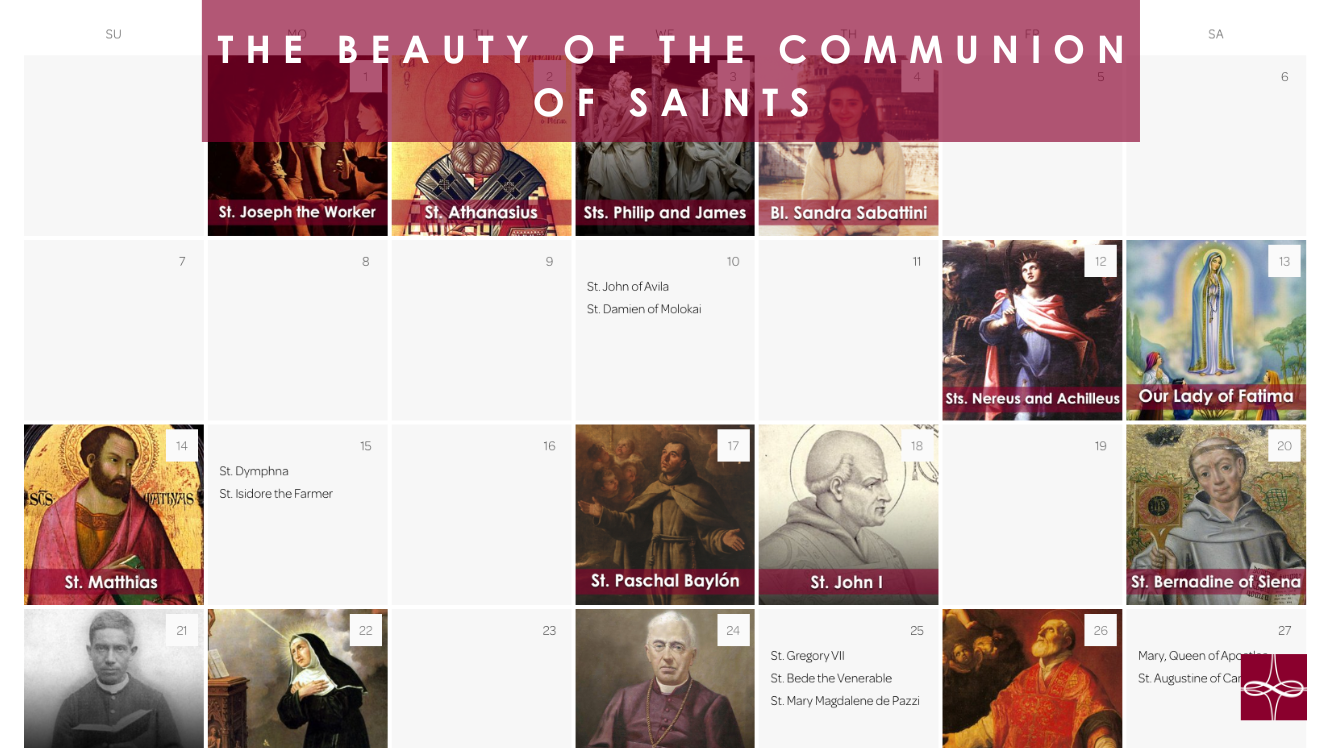
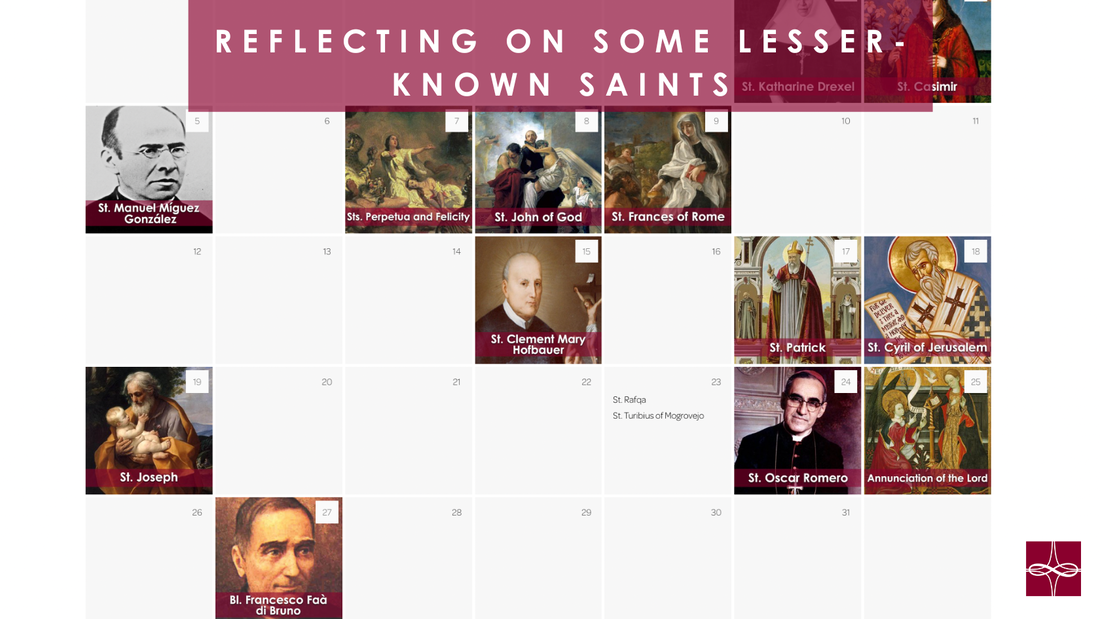
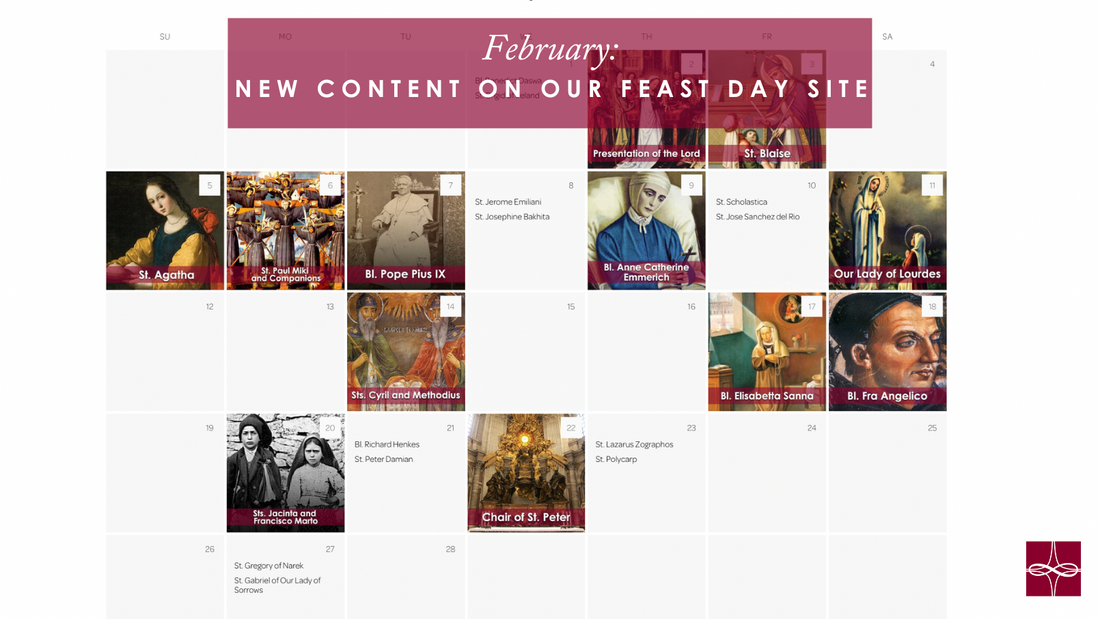
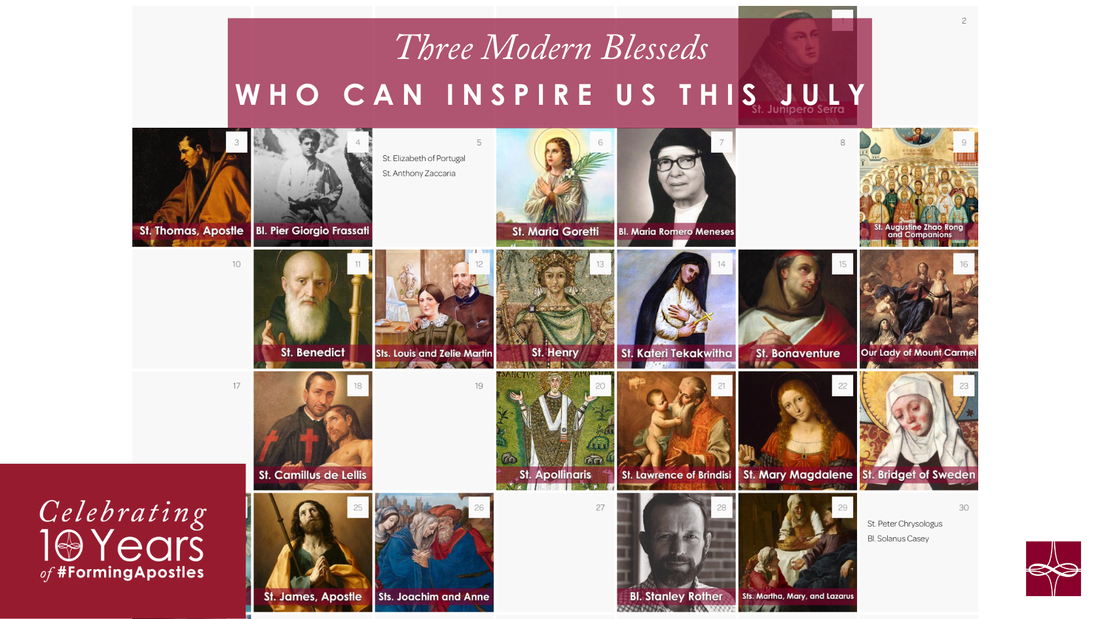
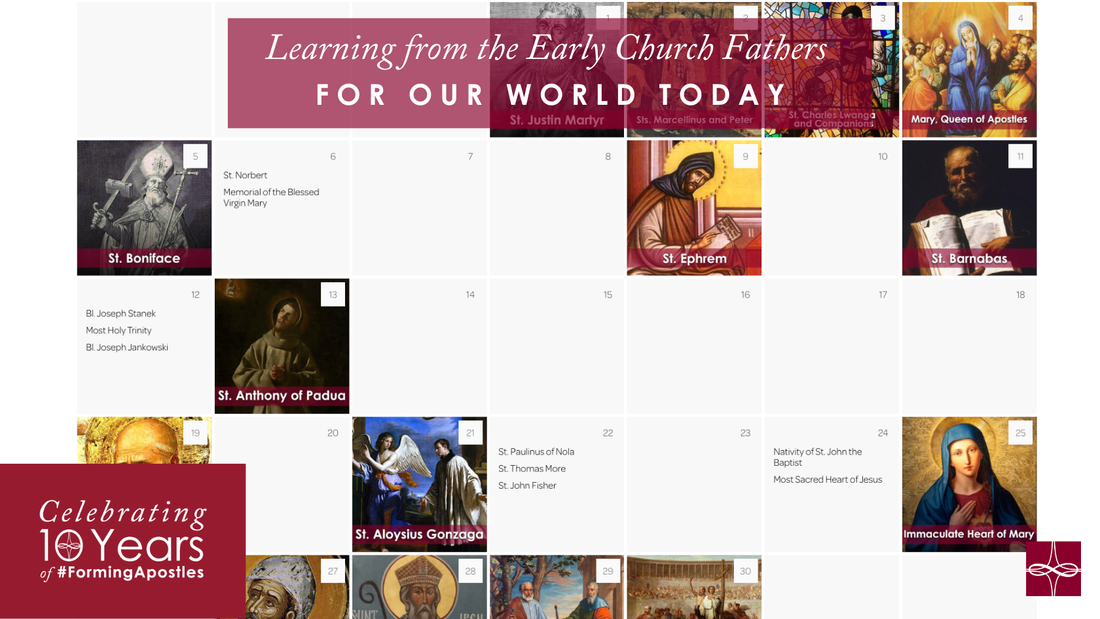

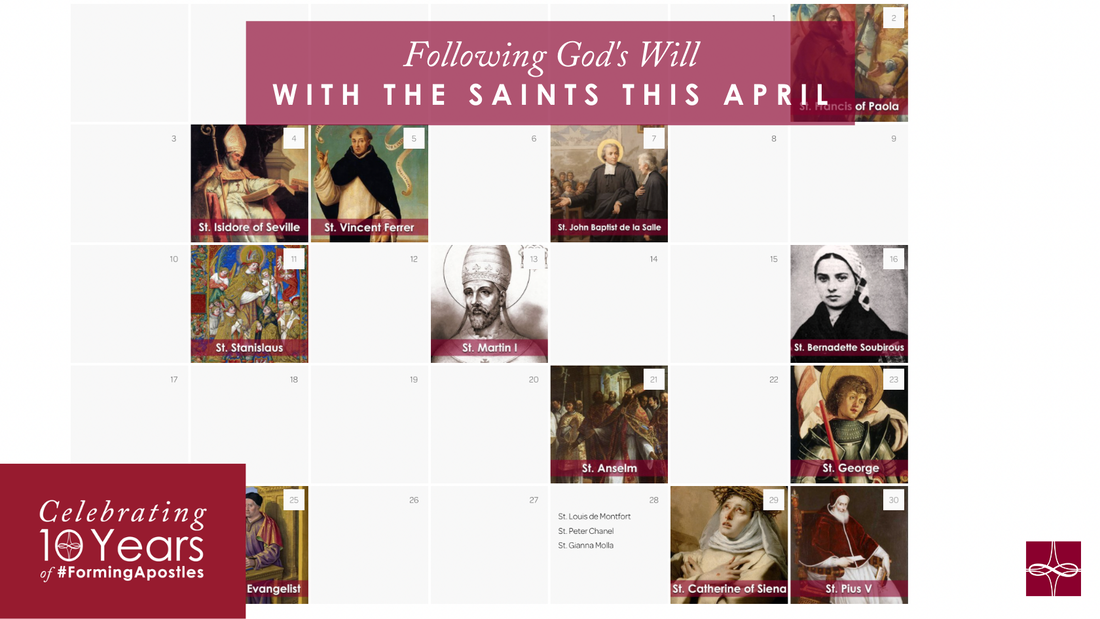
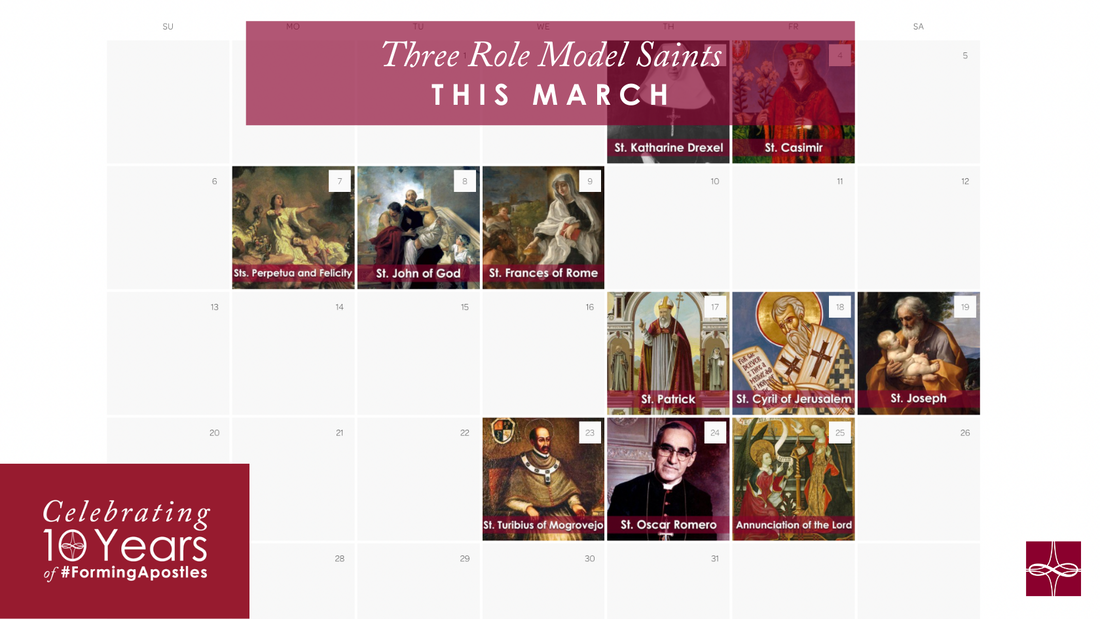
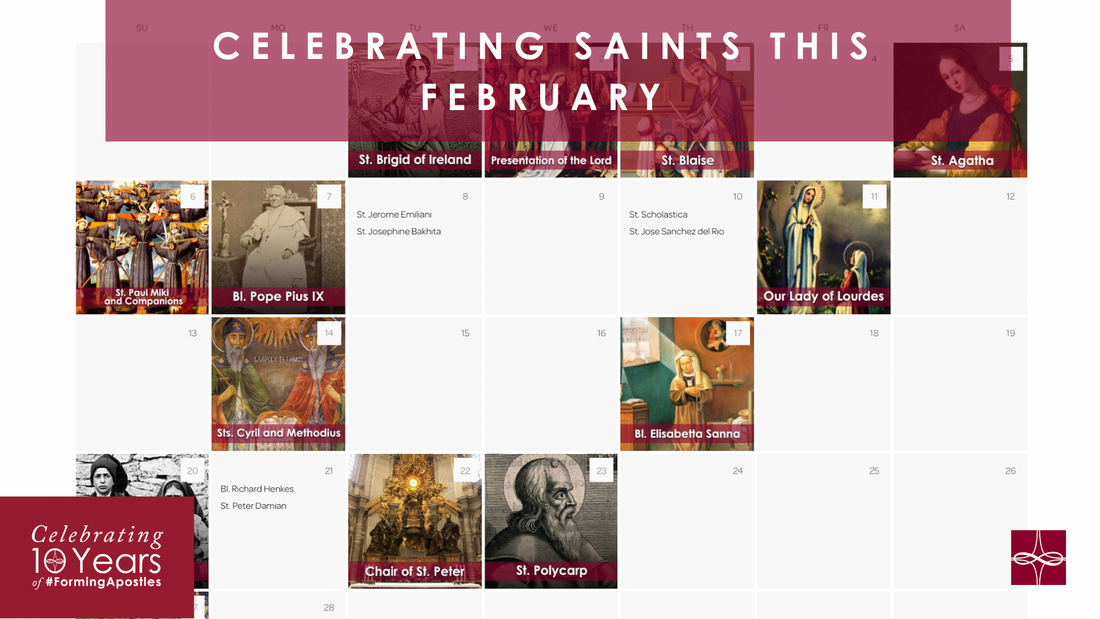
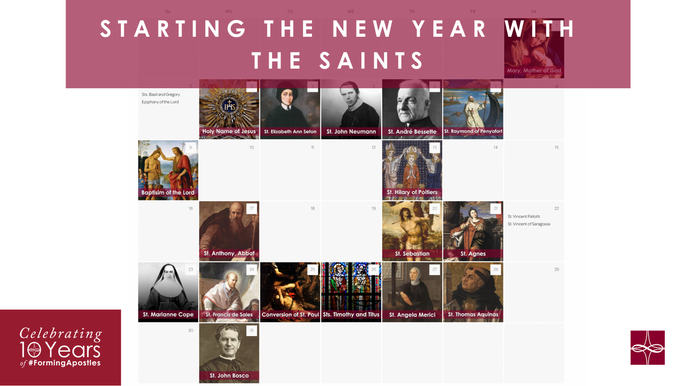
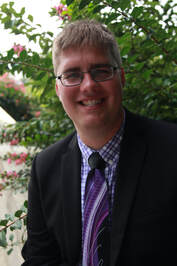
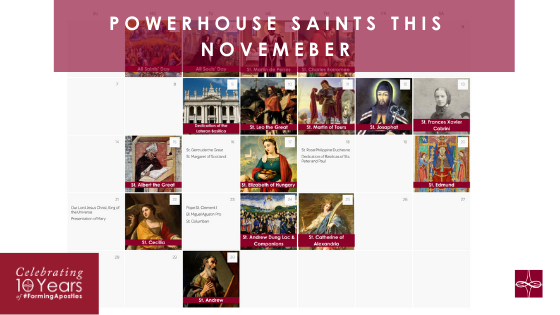
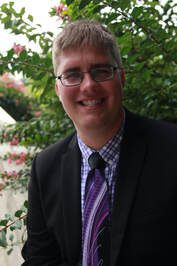
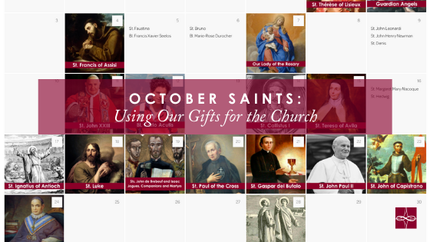
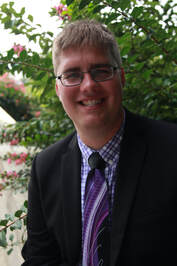
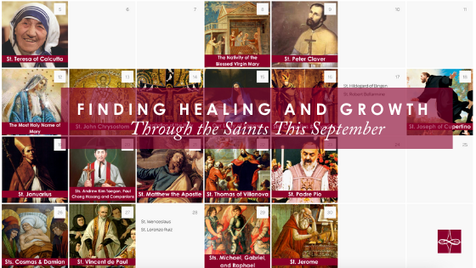

 RSS Feed
RSS Feed